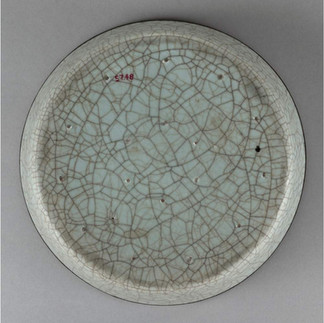A Collector’s Guide to Song Dynasty Ceramics: Subtlety, Prestige, and Timeless Value
- Keith Jennings
- Apr 17
- 8 min read
A refined overview of Song Dynasty ceramics, their history, and how to assess their value.

Among collectors of Chinese art and antiquities, Song Dynasty ceramics stand in a class of their own. Produced between 960 and 1279 CE, these vessels reflect an aesthetic defined by restraint, technical finesse, and philosophical depth. While they may appear modest at first glance, their value is very high.
Understanding what sets Song ceramics apart is essential for those involved in art appraisal, collection management, or the resale of high-value decorative objects. These works are not simply historical curiosities. They are among the most refined examples of ceramic artistry in the world, commanding attention from major museums, private collectors, and auction houses alike.
Table of Contents
Why Song Ceramics Remain Important
In contrast to the richly colored and ornate porcelain of later dynasties, Song wares emphasize quiet elegance. Glazes are subtle. Forms are clean. Decoration is minimal, if present at all. This emphasis on simplicity was influenced by the philosophical currents of the time, particularly Neo-Confucianism, which prized balance, moderation, and harmony with nature.
From a collector’s perspective, Song ceramics represent the height of aesthetic minimalism. From an appraiser’s standpoint, they require a nuanced understanding of kiln origins, glaze composition, form, and historical context. These objects reward close study and careful handling. They also require thoughtful evaluation to distinguish genuine works from later imitations.
Identifying the Hallmarks of Song Ceramics
Song wares are typically recognized by a few defining characteristics:
Monochrome glazes in celadon, ivory, pale blue, or slate grey tones
Graceful, symmetrical forms often without overt decoration
Surface effects like fine crackle, pooled glaze, or incised patterns beneath a translucent glaze
Thin walls and well-trimmed foot rims
High firing temperatures allowing stable, luminous finishes
While these traits appear understated, they reveal an intense focus on craftsmanship. Kiln masters refined firing techniques to reduce imperfections, and potters prioritized proportion and surface over embellishment. The result is a type of ceramic that looks deceptively simple but reflects deep technical and artistic knowledge.
The Five Great Kilns of the Song Period
The most prized Song ceramics come from five historically recognized kilns: Ru, Guan, Ge, Ding, and Jun. These were not a formalized group in their time but later recognized by scholars and collectors as the pinnacle of ceramic production during one of China’s most artistically influential eras. Each kiln developed distinct techniques, glazes, and aesthetics, contributing uniquely to the evolution of Chinese ceramics and offering appraisers clear markers of origin, quality, and value.
Ru Ware
Ru ware is considered the most prestigious and rarest of the Five Great Kilns. Located in what is now Ruzhou, Henan Province, the kiln flourished under the Northern Song Dynasty (960–1127), though its roots extend back to the Tang period. These pieces were created exclusively for the imperial court, and fewer than 100 authentic examples are known to exist today.
Ru ceramics are admired for their luminous bluish-green celadon glaze, often referred to as “sky after rain.” Their surfaces are smooth and thickly glazed, with a soft, jade-like texture. A signature feature is the presence of extremely fine crackles—known as "crab claw patterns"—across the surface. The base may show tiny firing marks from kiln supports, sometimes called "sesame-studded nails." The glaze often pools slightly, giving the piece subtle tonal variations.
Modern research has confirmed that agate was used as a flux in Ru glazes, contributing to their unique translucency and high material value. Excavations at the Qingliangsi kiln site in 2015 unearthed discarded agate stones, offering rare insight into the sophistication of the kiln’s materials and methods.
With so few confirmed pieces known, Ru ware is among the most sought-after categories in the global art market.
Guan Ware
Guan ware emerged in the aftermath of the Northern Song’s fall, when the court relocated south to Lin’an (modern-day Hangzhou). There, new official kilns were established at the base of Phoenix Mountain and in the Tortoise Hill area. Guan ware (meaning “official”) was produced exclusively for the Southern Song court and is often seen as a continuation of the aesthetic values embodied in Ru ware.
Its glaze is typically celadon, ranging from light blue to grayish-green, with a deliberate crackling, known as "crazing," which adds complexity. The body is usually dark, and when the glaze thins at the rim or base, the contrast creates a signature look described as “purple mouth and iron foot.” This term reflects the iron-rich clay body and the way it affects coloration at the edges.
The forms of Guan ware are often inspired by ancient bronzes from the Shang, Zhou, Qin, and Han dynasties. This connection to antiquity, combined with the ware’s austere beauty, made it highly prized among scholars and connoisseurs. Guan ware’s thick glaze and controlled surface decoration continue to set a high bar for ceramic refinement.
Ding Ware
The Ding kilns, located in present-day Quyang County, Hebei Province, began production during the Five Dynasties period and reached their artistic peak in the Northern Song and Jin dynasties. Ding ware is best known for its refined white glaze and paper-thin body, often incised or molded with floral or geometric patterns.
Early Ding ware included green-glazed pieces, but its white porcelain—developed in the late Tang and perfected by the Song—became the kiln’s hallmark. Many Ding wares were made as imperial tribute items, and some are inscribed with characters such as “官” (“official”) or “新官” (“new official”) to indicate their courtly status.
Most Ding pieces are functional forms like bowls and dishes. The rims were often left unglazed during firing and later fitted with metal mounts, typically silver or copper, both to protect the delicate edge and to enhance the aesthetic. These metal-rimmed examples are highly collectible today.
Jun Ware
Jun ware offers a striking contrast to the soft celadon glazes of Ru and Guan. Known for its dramatic glaze colors and unpredictable firing effects, Jun ceramics are rich in purples, blues, and moon-whites, sometimes blending together in abstract patterns across a single vessel. The kiln site is located in Yuzhou (ancient Junzhou), Henan Province.
Scholars debate whether Jun ware reached its peak during the Song, Jin, or Yuan dynasties, but it is widely accepted that the Song period marks its emergence as a distinctive style. Both imperial and civilian wares were produced.
Jun glazes often change color during firing, making each piece unique. A notable decorative effect is the so-called “earthworm crawling pattern,” where thick glazes fill cracks in a way that resembles the movement of earthworms across soil. Jun ware’s paint stroke-like glaze and color depth make it especially appealing to modern collectors. While less rare than Ru or Guan wares, high-quality Jun pieces remain in demand for their expressive surfaces and distinctive palette.
Ge Ware
Ge ware is perhaps the most mysterious of the Five Great Kilns. Its precise historical origin remains debated, and many surviving examples are associated with Qing Dynasty imperial collections, though classical texts mention it as early as the Yuan and Ming periods. Regardless of origin, Ge ware is best known for its distinctive double crackle glaze, featuring what is poetically described as “gold thread and iron wire.”
This refers to two contrasting networks of glaze crackles: thick, dark lines ("iron wire") and finer, lighter ones ("gold thread"). The effect evokes a sense of ancient beauty and deliberate imperfection. The glaze is typically pale gray, bluish-green, or beige, forming a subtle canvas for the web-like crackles. Because the glaze and body often cooled at different rates, the result is an elegant, mosaic-like surface with layered visual texture.
The uncertain provenance of Ge ware continues to intrigue scholars, but its crackled surfaces and refined forms remain an enduring favorite in both historical and contemporary collections.
Other Significant Kilns & Regional Styles
In addition to the five renowned kilns, the Song period saw production from a number of important regional centers. The Yaozhou kilns, located in northern China, specialized in celadon-glazed stoneware with carved decoration. These pieces often depict lotus flowers, vines, or fish beneath a smooth olive-green glaze.
Cizhou wares reflect a more populist sensibility. Bold designs, often created with black or brown slip on a white body, feature brush-painted motifs, calligraphy, or geometric patterns. These ceramics are more rustic in appearance but were widely used and exported, making them historically significant and increasingly collectible.
Appraising Song Ceramics: Key Considerations
Assessing Song ceramics involves more than identifying stylistic features. Appraising requires a combination of connoisseurship, historical knowledge, and technical analysis. Several factors directly influence valuation:
Authenticity: Many Song-style ceramics were replicated during later dynasties and into the modern period. Careful evaluation of form, glaze, and foot rim details is essential. Scientific testing such as thermoluminescence can assist in verifying age.
Condition: Minor glaze flaws or surface wear may not significantly affect value if consistent with age. However, chips, cracks, or extensive restoration can reduce desirability. That said, original repairs or metal additions can sometimes add historical interest.
Kiln of origin: Pieces attributed to Ru, Guan, or early Ding production often command higher valuations than regional or later kilns. Accurate attribution depends on glaze characteristics, firing technique, and shape.
Provenance: Items with documented histories—especially those linked to reputable collections or institutions—are more desirable. Provenance not only supports authenticity but also adds value in the eyes of buyers.
Rarity and Form: Unique or early examples, especially those in uncommon forms, tend to achieve stronger results at auction. Even smaller or functional items can be highly valuable if they show exceptional craftsmanship.
Current Market Outlook
The global market for Song ceramics is active and well-established. Pieces from the top kilns regularly appear at major auctions, sometimes realizing multi-million dollar results. Interest is driven by both cultural significance and rarity, with demand coming from museums, private collectors, and increasingly, institutional buyers across Asia and the West.
At the same time, there is growing appreciation for mid-tier and regional wares. Yaozhou bowls, Cizhou pillows, and Qingbai-glazed items offer collectors the opportunity to acquire authentic Song-era pieces at more accessible prices. These works are often well-suited to entry-level collectors or decorative arts buyers with an interest in historical materials.
The presence of Song ceramics in a collection should always prompt close inspection. Many of these objects are visually modest, and their value may not be immediately obvious. A small celadon dish or carved ewer, once overlooked on a shelf, may reveal itself to be a rare and important work of art.
The Role of the Appraiser
In the appraisal of Chinese ceramics, attention to detail is critical. Form, glaze, weight, surface texture, and base treatment must all be examined together. Understanding kiln-specific traits and changes over time allows an appraiser to place a work within the broader history of Chinese ceramics.
When presented with a potential Song piece, an appraiser's job is not only to determine fair market value, but to identify what makes the object special—its place in ceramic history, its quality, and its appeal to today’s market. This insight informs decisions around sale, donation, or conservation, and ensures that significant objects receive the recognition and treatment they deserve.
Conclusion
Song Dynasty ceramics exemplify the quiet refinement of a culture that found beauty in precision, balance, and restraint. Their subtle forms and glazes reveal the hand of artisans deeply connected to both material and philosophy. Today, they remain among the most esteemed and collectible of Chinese decorative arts.
For collectors and professionals working with Asian art, Song ceramics offer a compelling blend of technical excellence and market value. Whether encountered in a gallery, private collection, or family inheritance, these pieces deserve a close and informed look. Their appeal lies not in spectacle, but in the lasting impression of understated mastery.
Contact us today or take a look at our antique appraisal services.






































